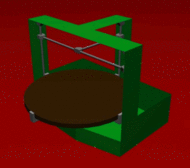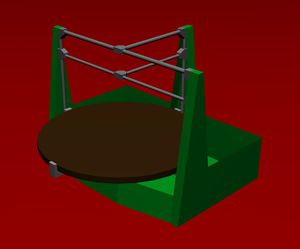Francisco
|
English • العربية • български • català • čeština • Deutsch • Ελληνικά • español • فارسی • français • hrvatski • magyar • italiano • română • 日本語 • 한국어 • lietuvių • Nederlands • norsk • polski • português • русский • Türkçe • українська • 中文(中国大陆) • 中文(台灣) • עברית • azərbaycanca • |
Release status: Concept
| Description | 3D Circular printer that prints 3 different materials
|
| License | |
| Author | |
| Contributors | |
| Based-on | |
| Categories | |
| CAD Models | |
| External Link | none
|
Contents
Project Description
I have some ideas in my mind. I support Zeitgeist, and I try to give my bit to improve this society. But from the different little projects that I have in my mind, some of them look stuck, or without a good reception, so they are not really an advantage for anyone. Then I decided to do something that could make the difference, that someone want to receive and that many people would use, and, apart of that, it gives a really good prize.
I'm designing a new Reprap with more capabilities, as printing 3 different materials, and with better quality. It's not easy, as all of you should already know, but we all learn of our mistakes, so any improvement of my machine that you want to say is welcome
Supporting The Venus Project.
The Gada Prize
The winner of the PM interim prize will be the inventor who can make a 3-D printer that can demonstrate the following:
- Print at least three different materials, including one that is usefully electrically conductive.
- The ability to print electronic circuit boards.
- Print beds† must be of a material which may be reused with minimal refurbishment for at least 20 print cycles.
- Maintain a total materials and parts cost under $200 and that 90% of the volume of the printer parts be printed. ††
- Demonstrate a build volume of the printer above 300x300x100mm in order to insure that items daily utility can be printed.
- The capacity to print a full set of parts for a complete replica of itself within 10 days unattended save for clearing no more than one printer head jam.
- The ability to print autonomously without a PC attached.
- Uses no more than 60 watts of electrical power.
†Print beds are flat surfaces onto which parts are printed.
††Print beds are not necessarily a permanent part of the printer and are not figured into either the cost or the volume requirements of a printer.
Project Goals
The goals are:
- Create a rotating bed that makes the horizontal surface of the printer to be less than 150% of the printable space (which is impossible with the actual Mendel model)
- The printable area is 300x300x100, but as it's a cylinder, it's Radius 220mm and Height 100mm
- If possible, it will print circuit boards
- If possible, a metal piece will remove the finished piece from the bed and clean it
Things to do
Printing materials
1: Some kind of plastic
2: High melting temperature plastic (more than tin)? Other material, like wax? it has to be a cheap material
3: Tin
Bed
Always rotating. Speed?
Working Notes. Maths
Working space (squared)=300x300x100mm
Here you can see a picture to make it more clear:
Here we can see that the L is the actual size of 300mm (as specified at Gada's Prize), so doing the maths (for example, Pythagorean theorem), we have that L²=R1²+R2²=R²+R²=2R²
L=R·√2
R=L/(√2)=300/(1,4142)=212.134, so I round it up, and make it 220mm of Radius.
Important to notice that in the central part the volume of MATERIAL that is released in a circle is smaller than in the borders of the circular beds, within the formula:
Rn>...>R2>R1
V=hπ(R2²-R1²)
So, the difference between the volume at the smallest circle and the biggest circle is:
Rn>R(n-1)>...>R2>R1
The difference between one radius and the next is, in all cases, 1 mm
Rn-R(n-1)=R4-R3=R2-R1=1 mm
Vs=hπ(R2²-R1²)=hπ·(1²-0)=hπ·1=hπ
Vb=hπ(Rn²-R(n-1)²)=hπ(220²-219²)=hπ·439 -> hπ=Vb/439
Vs=hπ=Vb/439 -> 439Vs=Vb -> The smallest circle has 439 times less volume of material than the biggest one!
Files and Parts
Print Bed
- A flat round bed of any non deformable material. I think glass would be great, but as the shape is a circle, I'd say wood is even better. A hardwood please. The bed's grips will be able to adjust to lower sizes (to 150 mm of Radius).
Extruder
- 3 Different extruders due to the difference of temperature, as it would make the low temperature melting materials to go all liquid when you tried to make the high temperature melting material to go liquid, messing everything.
Axes
- 3 Axes (90 degrees of each other), leaving the fourth gap to be free to take out the pieze and to the metal to cool a bit (it'd be the last one in the 3 extruders before of the little gap.


